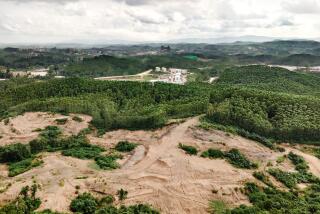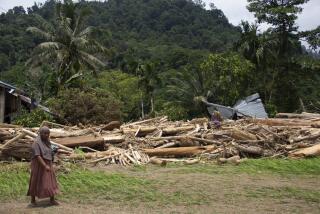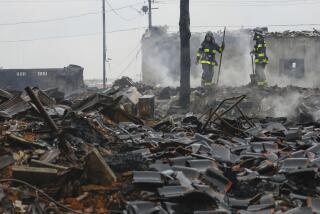Tsunami Toll in Indonesia Hits 531
- Share via
PANGANDARAN, Indonesia — Grief-stricken residents of this shattered beach community searched Tuesday for survivors of a 6-foot tsunami that wiped out coastal homes and hotels a day earlier, and the death toll rose to 531.
More than 200 people remained missing as volunteers and soldiers looked for bodies in the wreckage of buildings in this popular resort town on the southern coast of Java.
The wave swept as far as 500 yards inland, destroying houses and kiosks and wiping out the ground floor of hotels that line the beach.
Thousands of people fled inland to higher ground after a magnitude 7.7 earthquake struck about 150 miles off the coast Monday afternoon. But at least 1,000 more didn’t try to flee until it was too late.
Many were swept inland by the water, tumbling alongside battered boats, pieces of wood and other debris. Many survivors said they did not feel the quake, which struck about an hour before the tsunami.
Rukmana, who, like many Indonesians, uses only one name, said she was working at her small food stall at the beach when she saw people begin running. Moments later, she was swept up by the wave and washed inland. Her daughter and daughter-in-law both died; her granddaughter is missing.
“I did not feel any quake,” said Rukmana, 40, who has taken refuge in a mosque with her husband and hundreds of others. “I just saw people run everywhere. I did not know what happened. People ran, so I just ran. There were so many people by the beach.”
The government had planned to establish a national tsunami warning system after a massive tsunami hit the Indonesian island of Sumatra and several other nations in December 2004, killing more than 220,000 people. More than half the victims were in the Indonesian province of Aceh. But the warning system project has stalled.
Officials said Tuesday that they were alerted by the Pacific Tsunami Warning Center and Japan’s Meteorological Agency about 45 minutes before the wave struck Pangandaran. But Science and Technology Minister Kusmayanto Kadiman told reporters that the government did not publicize the warning because it did not want to cause unnecessary alarm.
“If it did not occur, what would have happened?” he asked reporters in Jakarta, the Indonesian capital.
Vice President Jusuf Kalla told reporters that there was no need to issue a warning because most people had fled inland after the earthquake.
“After the quake occurred, people ran to the hills,” he said, “so in actual fact there was a kind of natural early-warning system.”
In addition to the dead and missing, more than 700 people were reported injured. Nearly 800 buildings were damaged or destroyed, along with about 1,500 food stalls and hundreds of boats and cars.
Indonesia is one of the most seismically active regions in the world, with several active volcanoes and frequent earthquakes. Seven weeks ago, a magnitude 6.3 quake struck central Java, killing about 6,200 people. The death toll was high because many of the brick houses there had been built without mortar and collapsed easily.
Ujang Dedin Zainuddin, 25, who had a food stall at Pangandaran beach, said he saw the wave approach and wash away his wife and 5-year-old daughter. He said he wanted to help them but the wave swept him away too, carrying him to a school.
His wife’s body has been found, but he is still searching for his daughter.
“What have the people of Pangandaran done to deserve this disaster?” he asked. “What did we do wrong? Innocent people, like my daughter, got punished. I would rather die than have them die like this. Why did this happen? Why my wife, my daughter?”
Rescuers searched through the debris Tuesday in hopes of finding survivors, but the going was slow.
“It was hard for us, because we used only our bare hands while we had to search under the heavy walls of the hotels,” said Djadjat Sudrajat of the Red Cross, whose team recovered six bodies. “There was no heavy equipment until this afternoon.”
Buyung Hermanto, owner of the Hotel Anisa, said he was at the hotel when he felt the quake.
“I felt a very light shake, very soft,” he said. A short time later, he heard a sound like thunder and went outside. Hearing someone scream from a distance, “The water is high!” he raced upstairs.
Though officials estimated the wave’s height at 6 feet, he said it looked nearly 20 feet high. He helped several guests and employees get upstairs and then punched a hole in the ceiling so they could climb onto the roof. The wave was about 9 feet high when it reached the building, he said.
“The water hit the walls of my hotel lobby, and it collapsed,” he said. “It was very fast. We held on tight to the roof.”
He said most people did not think of a tsunami because the earthquake was so mild.
“Even when we know that the big tsunami happened in Aceh, and people said it would strike again somewhere else, we never knew when or where. So we did not prepare anything. We lived our life just as usual.
“We did not expect that it would be like this. We thought that it was just an ordinary earthquake.”
*
Jouhana reported from Pangandaran and Paddock from Bangkok, Thailand.
More to Read
Sign up for Essential California
The most important California stories and recommendations in your inbox every morning.
You may occasionally receive promotional content from the Los Angeles Times.










